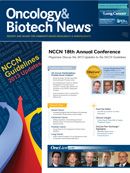Publication
Article
Oncology & Biotech News
Neoadjuvant Regimen May Not Require Chemotherapy in Some HER2-Positive Breast Cancer Patients
Author(s):
Some HER2-positive breast cancer patients may be able to receive targeted neoadjuvant therapy with lapatinib and trastuzumab without chemotherapy.
C. Kent Osborne, MD
Some HER2-positive breast cancer patients may be able to receive targeted neoadjuvant therapy with lapatinib and trastuzumab without chemotherapy, according to findings of a study by the Translational Breast Cancer Research Consortium (TBCRC).1
This phase II, single-arm, multicenter study was carried out at five sites across the United States between 2008 and 2010. Sixty-four HER2-positive women with invasive stage II-III disease deemed eligible for evaluation received a nonchemotherapy regimen of trastuzumab (4 mg/kg loading dose, followed by 2 mg/kg once weekly) and lapatinib (1000 mg once daily) over 12 weeks. Patients with estrogen- receptor (ER)— or progesterone-receptor (PR)–positive tumors also received one daily dose of letrozole (2.5 mg). The median age of study participants was 49; >50% of enrollees were premenopausal, and these women received a luteinizing hormone–releasing hormone agonist of their choice. Median tumor size was 6 cm.
Tumors were biopsied on four occasions: baseline, weeks 2 and 8, and at the end of study treatment. The pathologic complete response (pCR) rate was determined by whether all invasive tumor had disappeared from the breast (ypT0-is), the most common definition employed in other neoadjuvant studies, according to the researchers. The other study goal was the pathologic response rate, defined by investigators as pCR plus residual invasive disease of ≤1 cm (ypT1a-b) at the time of surgery.
The nonchemotherapy regimen achieved a pCR of 27%; pCR in the ER-positive and ER-negative subsets was 21% and 36%, respectively. The researchers noted that even when using a stricter definition of pCR (no residual invasive cancer in the breast or axilla [ypT0-is; ypN0]), the pCR was 22%. The overall pathologic response rate was 49%; in ER-positive and ER-negative patients, it was 54% and 40%, respectively.
Disease progressed in just two patients—each with ER- and PR-negative tumors—during the treatment period, and the regimen was generally well tolerated, with 6% of patients discontinuing treatment due to adverse events. Diarrhea (grades 1-2) was the most common toxicity, reported in 63% of patients, followed by skin rash (grades 1-2) in 55% of participants. Other events included fatigue (32%) and nausea (31%).
Jenny C. Chang, MD
The co-senior authors of the study were C. Kent Osborne, MD, director of both the Smith Breast Center and the Dan L. Duncan Cancer Center at Baylor College of Medicine, and Jenny C. Chang, MD, medical director of the Smith Breast Center and professor of Medicine at Baylor College of Medicine. Osborne, Smith, and colleagues noted that the rate of pCR achieved in the study with targeted therapy but without chemotherapy suggests that a subset of patients with HER2-positive breast cancer may exist who do not need chemotherapy.
The authors also noted that biomarkers needed to identify this subset still need to be determined and are currently being studied in tumor samples from this trial. Further, they wrote that their study demonstrates both the feasibility and the potential of neoadjuvant clinical trials employing rigorous biopsy schedules for determining new treatments and biomarkers.
In an accompanying editorial, Aleix Prat, MD, Vall d’Hebron Institute of Oncology, Barcelona, Spain, and José Baselga, MD, PhD, physician-in-chief, Memorial Sloan- Kettering Cancer Center, New York City, agreed with the study authors, writing that the research confirms that a pCR can be achieved in a sizable subset of HER2-positive tumors with the dual blockade, while noting the need for further study to determine a biomarker or combination of biomarkers that will clearly identify which patients will benefit.2 Prat and Baselga noted that among the biomarkers currently being tested are p95HER2, phosphatase and tensin homolog inactivation, cyclin E1 amplification, and PIK3CA mutations.
Reference
- Rimawi MF, Mayer IA, Forero A, et al. Multicenter phase II study of neoadjuvant lapatinib and trastuzumab with hormonal therapy and without chemotherapy in patients with human epidermal growth factor receptor 2—overexpressing breast cancer: TBCRC 006 [published online ahead of print April 8, 2013]. J Clin Oncol. doi:10.1200/ JCO.2012.44.8027.
- Prat A, Baselga J. Dual human epidermal growth factor receptor 2 (HER2) blockade and hormonal therapy for the treatment of primary HER2-positive breast cancer: one more step toward chemotherapy-free therapy [published online ahead of print April 8, 2013]. J Clin Oncol. doi: 10.1200/JCO.2012.48.4998.










